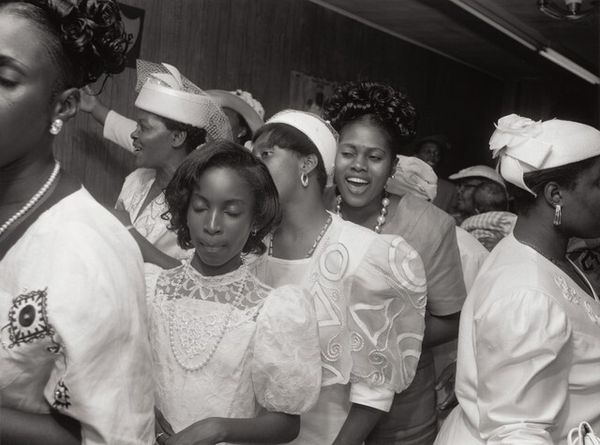
Dimensions: image: 24.1 × 32.5 cm (9 1/2 × 12 13/16 in.) sheet: 27.94 × 35.56 cm (11 × 14 in.)
Copyright: National Gallery of Art: CC0 1.0
Editor: So this is an untitled photograph by Thomas Roma, created in 1992, using the gelatin-silver print technique. It has a very intimate feel, like we are intruding on a private moment, yet also communal in its expression. What can you tell me about it? Curator: The process is key here. Gelatin-silver prints are fascinating because they are born from a very specific historical moment of industrial chemistry and photographic practice. Looking at the material production, how does the specific manipulation of light-sensitive emulsion impact the visual texture and emotional weight of this image for you? The tonal range from deep blacks to bright whites really grabs your attention. What would it communicate using more modern technologies? Editor: That's a good point. There is something unique about its visual impact, it's hard to achieve that with digital photos today. Curator: Absolutely. This print isn’t just capturing a scene; it's capturing the material reality of photography itself, as a commodity and an art form. Furthermore, note the community portrayed. How does the act of photographing—the labor and intent behind Roma's lens—affect how we interpret this moment of cultural celebration, or perhaps spiritual practice? Does it feel exploitative, documentative, or something else entirely? Editor: That's an angle I hadn't considered. Thinking about it now, the act of photographing it feels delicate. It is not about exploiting, but representing a community’s deep sentiment. Curator: Indeed. The 'how' and 'why' something is made are just as vital to understanding it as the 'what'. Editor: Thank you. It's helpful to think beyond the image to the artist’s intention and the historical background behind it, in appreciating art pieces like this one.
Comments
No comments
Be the first to comment and join the conversation on the ultimate creative platform.













